Your Call?
Today’s two featured images are quite similar. They are of the same bird and were taken just 27 seconds apart. Which pelican pose is the strongest? Why? For me, this one is a no-contest.
This Just In
Our landline (863-692-0906), has been giving us problems on and off for days. If you have left a message and not heard from us, please get in via e-mail. If you would like to leave a deposit for the first Fort DeSoto IPT, for one or both of the Homer IPTs, or for an In-the-Field session at ILE, please try me on my cell phone at 863-221-2372 and shoot me a text if I do not pick up.
ILE Baby Crane and Eagle In-the-Field Sessions
Right now, I have five tame baby cranes and two baby eagles here at ILE. Timing for a great learning and photo session has never been better. $300 for two solid hours of detailed photographic instruction from this Sunday onwards. We can fine-tune your date for the best weather. If you are interested in joining me, please get in touch via e-mail.
Galapagos 2023 Opening Filled!
Lake Morton In-the-Field veteran Bob Matyas will be joining the smallest Galapagos 2023 Photo-Cruise of a Lifetime IPT group ever. Why? Two folks signed up for single cabins. This trip is by far the world’s finest photographic cruise of the famed archipelago. I will be returning in August 2024. If you are interested or have questions, please get in touch via e-mail ASAP.
Iceland
My decades-long dream of spending time on Grimsey Island, Iceland, with the puffins — 13 days in this case!, will be realized this coming July. I am doing back-to-back trips as a participant. If anyone would like information on the world’s greatest Iceland/Atlantic Puffin trip this coming July, please contact me via e-mail.
What’s Up?
As I mentioned yesterday, Saturday was a Great Egret sort of morning. I was thrilled with my images. The longest series, of a clean, young bird on The Perch II in sweet early morning light featured many keepers and I learned a ton by working the bird off the BLUBB- at 600mm, 840mm, and 1200mm. The big surprise was a sharp head-shot-sequence of an even younger Great Egret (more black on the bill tip) capturing and swallowing a small fish. Photos and more soon.
Of yesterday’s two featured spoonbill images, I could not pick a winner. I love the soft pinks with no shadows in the 2nd image, but I also loved the vibrant pinks and blues in the sunlit flight shot. I had no problem at all with the shadow of the neck against the far wing, but was not in love with the shadow of the bird’s head on that same wing. I did lighten and take the Blues out of the latter shadow. Thanks to all who commented. The results were about 50/50 🙂
I was glad to learn the Bear Bob Sabine will be doing both 2024 Kachemak Bay sessions and that IPT veteran Sanjeev Nagrath has left a deposit for the second 2024 Bald Eagle IPT. Please do not hesitate long if you are thinking of joining me next year in Homer.
Today is Sunday 19 March 2023. Happy birthday to my daughter Jennifer, the CEO and accountant of BIRDS AS ART. She works here part time and three days a week as a lactation counselor at Sebring Hospital. The forecast for the morning is for cloudy with a north wind so I will be heading down to the lake to see what is up and about. I will be ending my second 38-hour fast at brunch when I get back from photographing.
This blog post took more than 90 minutes to prepare and makes three hundred fifty-three days in a row with a new educational post written just for you. Wherever you are and whatever you are doing, I hope that you too have a great day. My plan is to continue to post every day until the streak reaches one year and one day and then begin posting every other day. It won’t be long now!
Please remember to use the B&H and Amazon links that are found on most blog pages and to use the BIRDSASART discount code at checkout when purchasing your new gear from Bedfords to get 3% back on your credit card and enjoy free second-day air FedEx. Please, also, consider joining a BAA IPT. You will be amazed at how much you will learn!
You can find some great photo accessories (and necessities, like surf booties!) on Amazon by clicking on the Stuff tab on the orange/yellow menu bar above. On a related note, it would be extremely helpful if blog-folks who, like me, spend too much money on Amazon, would get in the habit of clicking on the Amazon logo link on the right side of each blog post when they shop online. As you might expect, doing so will not cost you a single penny, but would be appreciated tremendously by yours truly. And doing so, works seamlessly with your Amazon Prime account.
Please remember that if an item — a Delkin flash card, or a tripod head — for example, that is available from B&H and/or Bedfords, is also available in the BAA Online Store, it would be great, and greatly appreciated, if you would opt to purchase from us. We will match any price. Please remember also to use my B&H affiliate links or to earn 3% cash back at Bedfords by using the BIRDSASART discount code at checkout for your major gear purchases. Doing either often earns you free guides and/or discounts. And always earns my great appreciation.
The Stick Marsh Site Guide Subscription Service
The Site Guide Subscription Service was a new concept last year. I e-mailed the first issue in late-March 2022. The Basics e-mail includes specific directions to the site, and a map of the rookery area with specific instructions and wind, weather, and where-to-be advice. Sign up now to receive last year’s five e-mails and tomorrow’s very important update. Unfortunately, things at Stick Marsh are changing very soon.
To sign up for the Stick Marsh Site Guide Subscription Service, call Jim in the office weekday afternoons at 863-692-0906 with your credit card in hand or send a PayPal for the $100.00 to us at birdsasart@verizon.net. Please be sure to include the words Stick Marsh with your PayPal.
I fully understand that you can go to Google Maps, find Stick Marsh, visit, and likely make some good images. You might think, I can do fine just without artie’s advice. But you will do a whole lot better with it. Especially considering the new conditions and the coming change.
|
|
|
This image was created on 21 December while scouting for the San Diego IPTs. Standing at full height, I used the Robus RC-5558 Vantage Series 3 Carbon Fiber Tripod/Levered-Clamp FlexShooter Pro-mounted <Sony FE 400mm f/2.8 GM OSS lens and The One, the Sony Alpha 1 Mirrorless Digital Camera). The exposure was determined via Zebra technology with ISO on the Thumb Dial. ISO 800. 1/400 sec. at f/4 (stopped down 1-stop) in Manual mode. When evaluated in RawDigger, the raw file brightness was determined to be perfect (ho hum). AWB at 7:24:52am before the sun rose over the big hill to the east in La Jolla. Tracking: Expand Spot AF-C with Bird Face/Eye detection enabled performed to perfection. Be sure to click on the image to enjoy a high-res version. Image #1: Pacific-race Brown Pelican |
Picking Your 30-frames per second Keepers
On the recently concluded Homer/Kachemak Bay Bald Eagle IPTs, every participant who was not already using Photo Mechanic as their image browsing program purchased a license from BIRDS AS ART after they saw how quickly I picked my keepers. I helped all of the new Photo Mechanic (PM) folks set up the program and shared a few high levels tips with those who were already using PM.
Today’s two featured images were part of at least a 59-frame series featuring the same pelican. All of the exposures were perfect — thanks, as always, to Zebra technology, and all of the images were razor-sharp on the eye. Note that I did stop down one full stop for a bit more depth of field as I was relatively close to the relatively large subject. So, the big question is, how do you choose which two of 59 almost identical images to keep? I literally keep my finger on the right-facing arrow key, pausing only when something jumps off the screen at me. With long sequences of virtually identical images, I will simply tag one or two at random to compare during the second edit or when picking an image for the blog.
It looks as if I forgot to mention that PM is blazingly fast. Oh, and by the way, the image review sessions on all IPTs are huge favorites as I teach folks to recognize the fine points that make one image slightly better than another, of much better than many similar images.
|
|
|
This image was created on 21 December while scouting for the San Diego IPTs. Standing at full height, I used the Robus RC-5558 Vantage Series 3 Carbon Fiber Tripod/Levered-Clamp FlexShooter Pro-mounted Sony FE 400mm f/2.8 GM OSS lens and The One, the Sony Alpha 1 Mirrorless Digital Camera). The exposure was determined via Zebra technology with ISO on the Thumb Dial. ISO 800. 1/400 sec. at f/4 (stopped down 1-stop) in Manual mode. When evaluated in RawDigger, the raw file brightness was determined to be perfect (ho hum). AWB at 7:25:19am before the sun rose over the big hill to the east in La Jolla. Tracking: Expand Spot AF-C with Bird Face/Eye detection enabled performed to perfection. Be sure to click on the image to enjoy a high-res version. Image #2: Pacific-race Brown Pelican |
Color Mixer
Six months ago, I began using the Color Mixer tab while converting my Sony A1 files in Adobe Camera Raw. ACR is identical in Photoshop and Lightroom. And Capture One offers a similar feature. I have finally begun compiling a folder of images to be used in a Color Mixer video e-Guide. Though I first got into using Color Mixer with the Blues, with today’s featured images I made adjustments to both the Saturation and/or Luminosity sliders for all seven colors: Reds, Oranges, Yellows, Greens, Aquas, Blues, Purples, and Magentas.
Your Call?
Today’s two featured images are quite similar. They are of the same bird and were taken just 27 seconds apart. Which pelican pose is the strongest? Why? For me, this one is a slam dunk. I will share my thoughts on the two images here tomorrow, along with the reasons for my choice.
|
|
|
This all-new card includes images created on my JAN 2022 visit to San Diego. Click on the composite to enjoy a larger version. |
The 2023/2024 San Diego Brown Pelicans (and more!) IPTs
San Diego IPT #1. 3 1/2 DAYS: WED 27 DEC thru the morning session on Saturday 30 DEC 2023. $2099.00. Deposit: $699.00. Limit: 6 photographers.
San Diego IPT #2. 4 1/2 DAYS: TUES 9 JAN thru the morning session on SAT 13 JAN 2024: $2699.00. Deposit: $699.00. Limit: 6 photographers.
San Diego IPT #3: 4 1/2 DAYS: TEUS 23 JAN thru the morning session on SAT 27 JAN 2024: $2699.00. Deposit: $699.00. Limit: 6 photographers.
Please e-mail for information on personalized pre- and post-IPT morning sessions.
Join me in San Diego to photograph the spectacular breeding plumage Brown Pelicans with their fire-engine red and olive green bill pouches; Brandt’s (nesting) and Double-crested Cormorants; breeding plumage Wood and Ring-necked Ducks; other duck species possible including Lesser Scaup, Redhead, Northern Shoveler and Surf Scoter; a variety of gulls including Western, California, and the gorgeous Heermann’s, all in full breeding plumage; shorebirds including Marbled Godwit, Willet, Sanderling and Black-bellied Plover; many others are possible including Least, Western, and Spotted Sandpiper, Whimbrel, Black and Ruddy Turnstone, Semipalmated Plover, and Surfbird; Harbor Seals and California Sea Lions (both depending on the current regulations and restrictions). And as you can see by studying the IPT cards, there are some nice bird-scape and landscape opportunities as well. Not to mention a ton of excellent flight photography opportunities and instruction.
I discovered some really neat spots on my 2022/23 visit. As a result, the first and second IPTs may include an afternoon or two of landscape photography.
Please note: where permitted and on occasion, ducks and gulls may be attracted (or re-located) with offerings of grains or healthy bread.
|
|
|
San Diego offers a wealth of very attractive natural history subjects, including and especially the Pacific race of California Brown Pelican. With annual visits spanning more than four decades, I have lots of photographic experience there … Click on the composite to enjoy a larger version. |
Learning Exposure, Whether You Like It Or Not
Whether you like it or not, we will be beating the subject of exposure like a dead horse. In every new situation, you will hear my thoughts on exposure along with my thoughts on both Nikon and Canon histograms and SONY Zebras. Whether you like it or not, you will learn to work in manual mode so that you can get the right exposure every time (as long as a bird gives you ten seconds with the light constant). Or two seconds with SONY zebras … And you will learn what to do when the light is changing constantly. What you learn about exposure will be one of the great takeaways on every IPT.
|
|
|
Though the pelicans will be the stars of the show on this IPT, there will be many other handsome and captivating subjects in wonderful settings. Click on the composite to enjoy a larger version. |
It Ain’t Just Pelicans
With gorgeous subjects just sitting there waiting to have their pictures taken, photographing the pelicans on the cliffs is about as easy as nature photography gets. With the winds from the east almost every morning, there is usually some excellent flight photography, at times with 70-200mm lenses! And the pelicans are almost always doing something interesting: preening, scratching, bill pouch cleaning, or squabbling. And then there are those crazy head throws that are thought to be a form of intra-flock communication. You will be guided as to how to make the best of those opportunities. Depending on the weather, the local conditions, and the tides, there are a variety of other fabulous photo chances available in and around San Diego. Each IPT will include one or two duck sessions.
|
Did I mention that there are lots of great birds and natural history subjects in San Diego in winter? Click on the composite to enjoy a larger version. |
The San Diego Details
These IPTs will include four or five 3-hour morning photo sessions, three or four 1 1/2-hour afternoon photo sessions, and three or four working brunches that will include image review and Photoshop sessions. On rare cloudy days, we may — at the leader’s discretion, stay out in the morning for a long session and skip that afternoon shoot. To ensure early starts, breakfasts will be your responsibility. And so that we can get some sleep, dinners will be on your own as well. In the extremely unlikely event that Goldfish Point is closed due to local ordinance (or whimsy) — that has never happened in the past fifty years, I will of course do my very best to maximize our photographic opportunities.
|
|
|
San Diego offers a wealth of very attractive natural history subjects, including and especially the Pacific race of California Brown Pelican. With annual visits spanning more than four decades, I have lots of photographic experience there … Click on the composite to enjoy a larger version. |
Deposit Info
A $699 deposit is required to hold your slot for one of the 2023/2024 San Diego IPTs. You can send a check (made out to “BIRDS AS ART”) to us here: BIRDS AS ART, PO Box 7245, Indian Lake Estates, FL, 33855, or call Jim or Jennifer at the office with a credit card at 863-692-0906. Your balance, payable only by check, is due three months before the trip.
|
Variety is surely the spice of life in San Diego. Click on the composite to enjoy a larger version. |
Getting Up Early and Staying Out Late
On all BIRDS AS ART IPTS including and especially the San Diego IPT, we get into the field early to take advantage of unique and often spectacular lighting conditions and we stay out late to maximize the chances of killer light and glorious sunset silhouette situations. We often arrive at the cliffs a full hour before anyone else shows up to check out the landscape and seascape opportunities.
Typos
With all blog posts, feel free to e-mail or to leave a comment regarding any typos or errors.

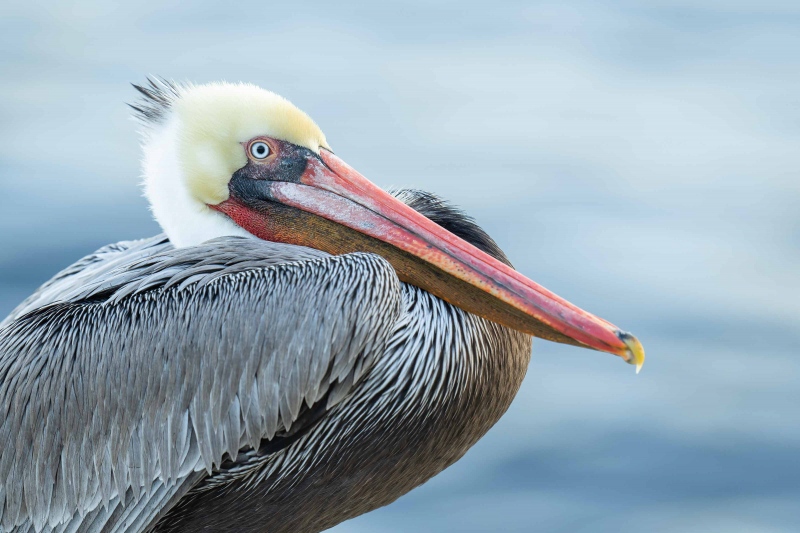
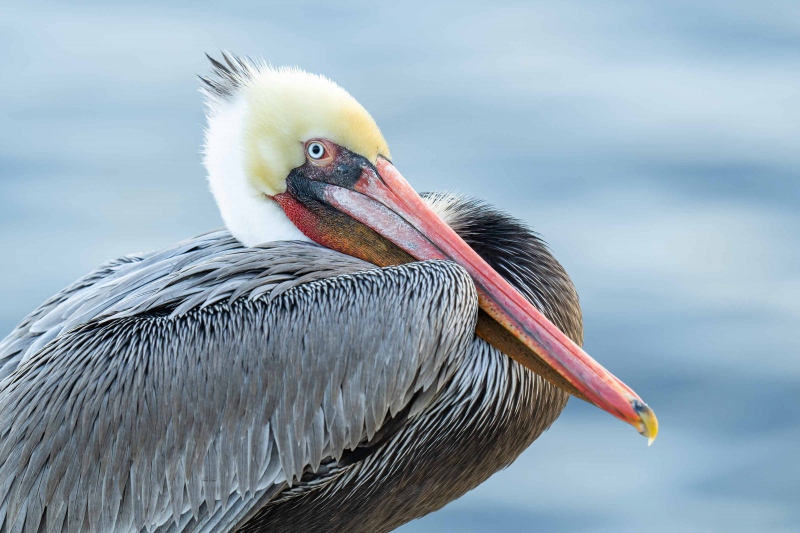
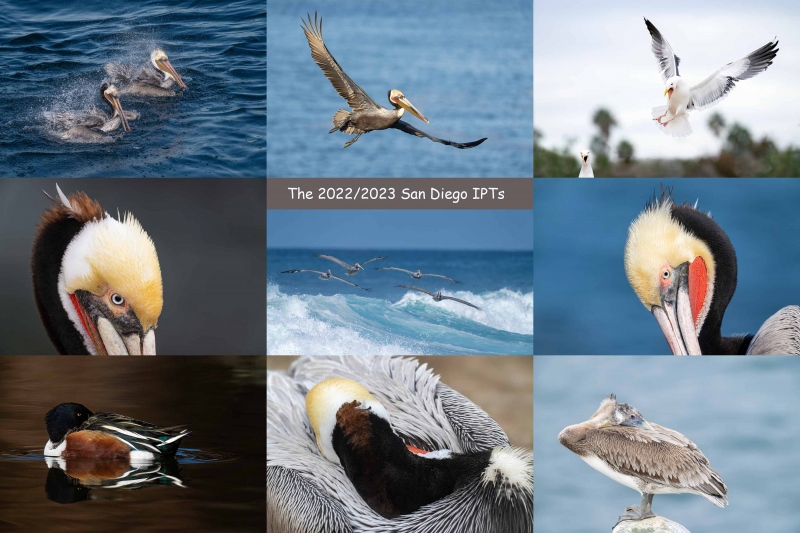
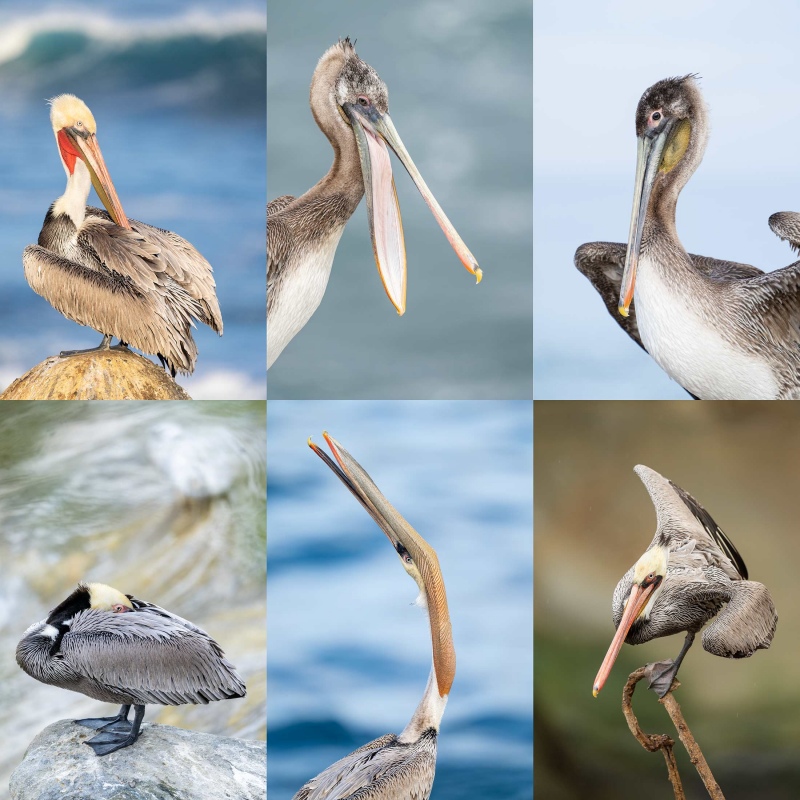
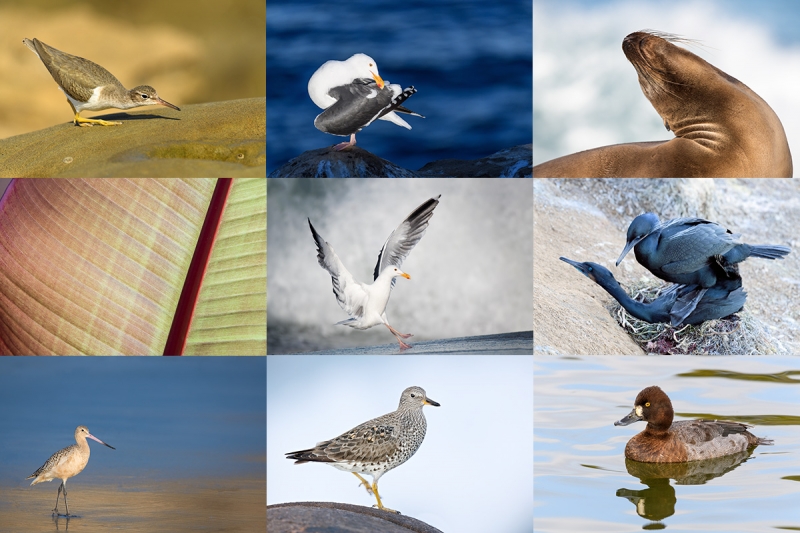

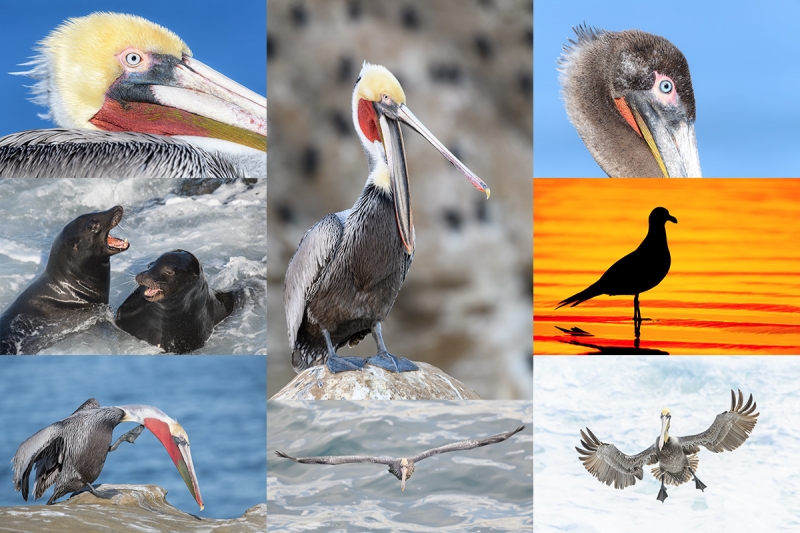














Image #1 for me because the wing does not merge with the pink/red of the bill as it does in Image #2. I have been using Tony Kuyper’s, free, camera specific linear profiles in ACR for all of my RAW optimizing – love them.
I think the most significant difference is the eye/head angle. Would pick #2 as the pelican is making some contact with the viewer, adding interest.
Image two Artie the bird is a little more erect and has better HA.I also like that the breast sticks out more behind the bill. Just wish the near wing was lower on the bill as not to be as obtrusive.
Hard to get perfection. Have a good one.
I prefer #2 because of the eye direction
I do see a contest here. I prefer the water in Image 1 (especially the blue above the bird’s back, which adds contrast) and the less centered composition. On the other hand, as others have said, in Image 2 the turn of the eye toward the viewer and the more buried position of the bill give the bird a more dynamic look and make for a stronger image overall.
Images #1 and #2 Pacific-race Brown Pelican are both good and cute!! Both seem almost the same and just a little different from image #1 to image #2. I really like both of them!
I prefer #2 for the more direct eye contact. The more obvious intersection of the bill and wing also adds nice depth to the image.
Artie
I learned tons from you in the past month however my Brainer is saying image #1 I see more bill and pouch that are of interest to me it is a minor amount however image 2 does have more action if you will but for my liking it is image 1 as said above. It is not by a lot but in image 2 I do like the sharpness from the eye to the right wing and the detail is amazing. Image 1 is equally sharp however I am still drawn to image 1
Always with love b
As indicated, it’s very close, but my preference is for Image 1, due to the improved right wing feather detail.
#2 for me. Head angle, background and more breast makes it sing! Great job Artie!
#2 for me. I like the wings pulled more forward over the bill, (maybe showing warming?) Wing or back feathers, can’t tell which, show up better in 2. And 2 seems a little sharper.
I, too, mixed up breast and wing. Still like 2 better and now, thanks to the comments, I notice the better head angle too.
Hi, Artie. It’s not a slam-dunk for me but I prefer image 2. If you’re going to see the left wing it’s better being really visible than an apparent afterthought. I prefer the head position, too.
Thanks, David. I think that what you are seeing is the breast.
a
Thanks, Artie. When I looked again on my computer (as opposed to my phone) I could see that it’s breast, not wing, that I’m seeing. Doesn’t change my preference, though!